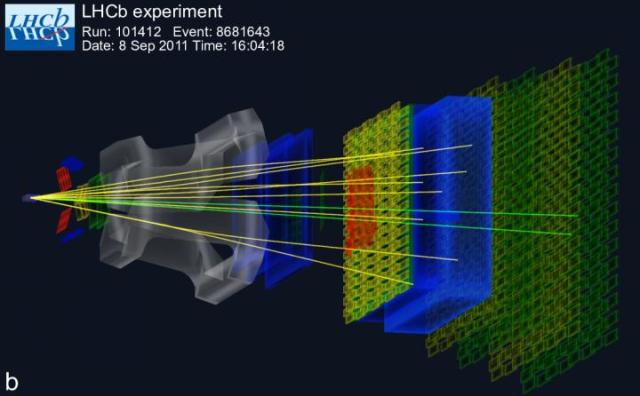Aug 28 2015
The Standard Model of particle physics, which explains most of the known behaviors and interactions of fundamental subatomic particles, has held up remarkably well over several decades. This far-reaching theory does have a few shortcomings, however--most notably that it doesn't account for gravity. In hopes of revealing new, non-standard particles and forces, physicists have been on the hunt for conditions and behaviors that directly violate the Standard Model.
 In this event display from the LHCb experiment at CERN's Large Hadron Collider, proton-proton collisions at the interaction point (far left) result in a shower of leptons and other charged particles. The yellow and green lines are computer-generated reconstructions of the particles' trajectories through the layers of the LHCb detector. Credit: CERN/LHCb collaboration
In this event display from the LHCb experiment at CERN's Large Hadron Collider, proton-proton collisions at the interaction point (far left) result in a shower of leptons and other charged particles. The yellow and green lines are computer-generated reconstructions of the particles' trajectories through the layers of the LHCb detector. Credit: CERN/LHCb collaboration
Now, a team of physicists working at CERN's Large Hadron Collider (LHC) has found new hints of particles--leptons, to be more precise--being treated in strange ways not predicted by the Standard Model. The discovery, scheduled for publication in the September 4, 2015 issue of the journal Physical Review Letters, could prove to be a significant lead in the search for non-standard phenomena.
The team, which includes physicists from the University of Maryland who made key contributions to the study, analyzed data collected by the LHCb detector during the first run of the LHC in 2011-12. The researchers looked at B meson decays, processes that produce lighter particles, including two types of leptons: the tau lepton and the muon. Unlike their stable lepton cousin, the electron, tau leptons and muons are highly unstable and quickly decay within a fraction of a second.
According to a Standard Model concept called "lepton universality," which assumes that leptons are treated equally by all fundamental forces, the decay to the tau lepton and the muon should both happen at the same rate, once corrected for their mass difference. However, the team found a small, but notable, difference in the predicted rates of decay, suggesting that as-yet undiscovered forces or particles could be interfering in the process.
"The Standard Model says the world interacts with all leptons in the same way. There is a democracy there. But there is no guarantee that this will hold true if we discover new particles or new forces," said study co-author and UMD team lead Hassan Jawahery, Distinguished University Professor of Physics and Gus T. Zorn Professor at UMD. "Lepton universality is truly enshrined in the Standard Model. If this universality is broken, we can say that we've found evidence for non-standard physics."
The LHCb result adds to a previous lepton decay finding, from the BaBar experiment at the Stanford Linear Accelerator Center, which suggested a similar deviation from Standard Model predictions. (The UMD team has participated in the BaBar experiment since its inception in 1990's.) While both experiments involved the decay of B mesons, electron collisions drove the BaBar experiment and higher-energy proton collisions drove the LHC experiment.
"The experiments were done in totally different environments, but they reflect the same physical model. This replication provides an important independent check on the observations," explained study co-author Brian Hamilton, a physics research associate at UMD. "The added weight of two experiments is the key here. This suggests that it's not just an instrumental effect--it's pointing to real physics."
"While these two results taken together are very promising, the observed phenomena won't be considered a true violation of the Standard Model without further experiments to verify our observations," said co-author Gregory Ciezarek, a physicist at the Dutch National Institute for Subatomic Physics (NIKHEF).
"We are planning a range of other measurements. The LHCb experiment is taking more data during the second run right now. We are working on upgrades to the LHCb detector within the next few years," Jawahery said. "If this phenomenon is corroborated, we will have decades of work ahead. It could point theoretical physicists toward new ways to look at standard and non-standard physics."
With the discovery of the Higgs boson--the last major missing piece of the Standard Model--during the first LHC run, physicists are now looking for phenomena that do not conform to Standard Model predictions. Jawahery and his colleagues are excited for the future, as the field moves into unknown territory.
"Any knowledge from here on helps us learn more about how the universe evolved to this point. For example, we know that dark matter and dark energy exist, but we don't yet know what they are or how to explain them. Our result could be a part of that puzzle," Jawahery said. "If we can demonstrate that there are missing particles and interactions beyond the Standard Model, it could help complete the picture."
Source: http://cmns.umd.edu/